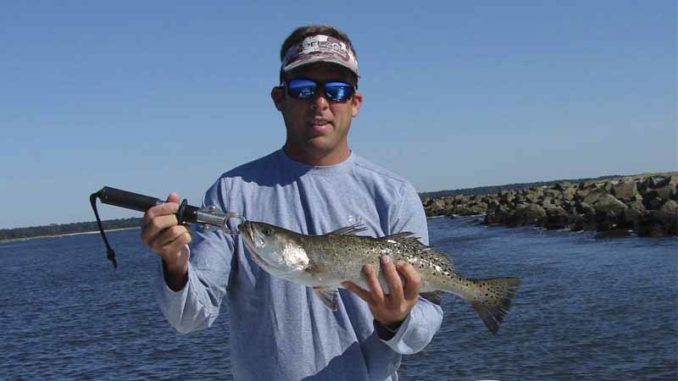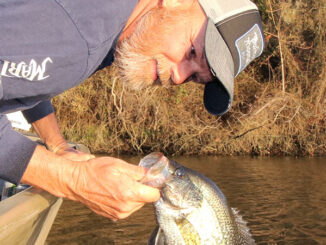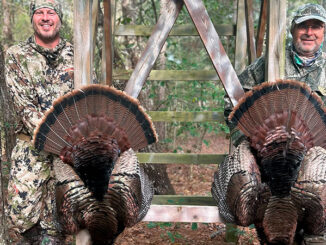
From Little River to Sunset Beach, fishermen in both Carolinas can jump in on a great trout bite in November.
Fall is often a very long season along the coast close to the North Carolina/South Carolina border, between North Myrtle Beach and Sunset Beach. The area seems to be south of the areas that get the biggest cold fronts in the fall. At times, that cold weather may dip into this area. But it is usually only for a day or two, and the weather warms right up after it passes. Fishing may slow for a couple of days, but most of the time, it recovers. And often, specks and other fish are more active than before the weather change.
Brandon Sauls, a retired guide from Ocean Isle Beach, N.C., still loves to chase speckled trout. He regularly fishes the creeks, rivers, marshes, inlets and the Intracoastal Waterway from North Carolina’s Shallotte River to the basins and creeks behind North Myrtle Beach. He fishes waters that vary from so protected and shallow that he sometimes has to get out and push his flats skiff across sandbars, to places he only feels comfortable in his 24-foot bay boat.
Sauls enjoys the excitement of catching trout on topwater lures and fishes them as long as the trout cooperate. Some years that lasts into November, but occasionally a cold front shuts that bite down earlier. As the water cools, he concentrates on creeks and pockets in the marsh where the water is a few degrees warmer and trout are a little more active. These areas will typically be shallow but adjacent to deeper water. The sun can penetrate to the bottom and warm the water better than it can in deeper water.
Always be prepared with topwater lures
“I always head out with two rods rigged with topwaters,” Sauls said. “One is a MirrOlure Top Dog, and the other is a Zara Super Spook Junior. They have different profiles and are different sizes, but the big difference may be their sound. The Top Dog is larger and has a lower-frequency rattle, while the Super Spook Junior is smaller, with a high-frequency rattle. Some days the specks only want one or the other, and occasionally they are hungry and attack both.”
Sauls said to pay attention to how baitfish are moving and to work your lure like the bait. Bait will typically be moving along the bank just on the shallow side of a drop or small ledge. Trout tend to stay in the deeper water and rush up to attack the bait.
“We have a couple of areas just inside the inlets where it is generally shallow, but trout tend to congregate,” Sauls said. “Some of these have sand bottoms rather than mud, and I don’t know why that appeals to the trout, but it does. In these areas, I begin by fan-casting the entire area. Some days, the trout will be scattered, and some days, they will concentrate in a specific spot.”
Sauls said trout always bite best on a moving tide, and those close to the inlets often prefer a rising tide. He believes this preference is due to the cleaner ocean water also carrying bait. When bait starts moving, it usually gets the trout going.
Look for specks at the “Crossroads”
Another place Sauls has some success catching trout using topwaters is along the oyster banks at the “Crossroads,” where the Calabash River crosses the Intracoastal Waterway on its way to Little River Inlet. Most of this is in South Carolina, but when you get up the Calabash River beyond the clubhouse at Ocean Harbor Golf Club, you cross into North Carolina. Sauls said the oyster-laden banks extend south down the Intracoastal Waterway and around Tillman’s Point to the entrance to Dunn Sound.
“Later in the month, when the water cools to about 60 degrees, the specks aren’t as aggressive and stop chasing topwaters,” Sauls said. “Then, I switch to primarily live shrimp as long as I can get them. Trout like shrimp and will usually bite them even when they let other baits pass.”
Sauls mainly fishes live shrimp suspended a foot or so off the bottom under a float. He uses a pencil float rather than a popping float; he believes its lower resistance to being pulled under helps hook trout that bite tentatively. A trout can pull the cork under while tasting the shrimp and then get the hook when it gulps the rest.
Sauls makes his float rig with a bobber stopper and bead above the pencil float so he can quickly and easily adjust the depth. He uses a 1/2-ounce egg sinker to keep the cork upright and pull the bait down. There is a swivel just below the egg sinker and a 15- to 18-inch fluorocarbon leader down to a No. 6 gold treble hook. He lightly slips one of the treble’s barbs under the shrimp’s horn.
Switch it up when the situation warrants
This rig will also tell if something is wrong. If the float is on its side, the rig is tangled or the water is too shallow for its depth setting.
“Unfortunately, at some point the water will get cold enough live shrimp will be almost impossible to catch,” Sauls said. “I occasionally mix a Vudu shrimp in with the live shrimp to see if specks will hit it too. When I can’t find live shrimp any longer, I switch to Vudu shrimp. Meanwhile, if the trout are feeding good and will hit them, it extends the live shrimp I have.”
Sauls’ only modification to his cork rig for fishing the soft plastic artificial is to remove the treble hook and attach it to the end of the leader.
“I believe having live shrimp in cool water is important enough I sometimes rearrange my work schedule to go catch them, even if I have to do it several days before a fishing trip,” Sauls said. “Live shrimp will easily live several days in an aerated container once the water cools. If you can leave them in a creek or change the water every few days, you can keep them for quite a while.”
Catch your own shrimp whenever possible
To catch shrimp in cool water, Sauls said it is best to go on a low tide when shrimp will be flushed out of the grass and any small creeks that run dry or almost dry. Forced to gather in deeper pools, they are easier to catch. Live shrimp are often available in bait shops in early November, but by the end of the month they get scarce.
“At the point I switch to primarily fishing with live shrimp, the water has cooled and trout have moved deeper,” Sauls said. “A few may be shallower, but most are in at least several feet of water. Trout will readily eat shrimp just about anytime, but so will pinfish, sand perch and a host of other small fish. The cooler water moves along many of the bait thieves, and a live shrimp should last long enough to get a trout’s attention.”
On a trip last fall to the Little River Inlet Jetties, Sauls and his friend, Mark Stacy of Ocean Isle Fishing Charters, picked at the trout for the last few hours of a falling tide and then began to connect regularly as the rising tide pushed new, clean water into the inlet. They were anchored parallel to one of the jetties and using the tide to drift squirming live shrimp along it.
“Set your bobber stopper about 5 feet up from the cork and cast about 10 feet from the jetty, Sauls said. “There are rocks out a ways, and that should be about the right depth.”
Anglers catch specks of all sizes during the fall
It took a few drifts, but suddenly the specks had seen enough and floats began going under. Sauls and Stacy had caught a few average trout when Sauls’ rod bent deeply and his reel squealed as it gave up line.
“I’m pretty sure this is going to be a better fish,” Sauls said. “The tide has been rising, and I cast a couple of feet closer to the jetty to see if I could drift through there, and he nailed it. I feel his head shaking, so I’m pretty sure it isn’t a black drum trying to steal my bait. Maybe the bigger fish are a little shallower on this rising tide.”
The bite continued for a while, but about mid-tide it began to taper off. Sauls tried several other places along the jetty and connected with a few specks, but nothing was outstanding. He watched the water level creep up on the jetty rocks, and after a while, he decided the tide had risen enough to check several spots a few miles inland.
Try these spots for specks
Sauls said the jetties are the primary spot most fishermen think of for fall specks along the state line. He agrees they are productive, but he said wind or sea conditions sometimes won’t allow fishing there. Sauls said not to forget the places that held trout for topwaters a few weeks earlier and check for deeper areas near them. When you fish oyster banks like those at the Crossroads, try to locate the drop into deeper water and drift your shrimp along it.
Several other places that Sauls recommended for catching trout in colder water are along the riprap at the entrance to Coquina Harbour Marina and around the Ocean Isle and Sunset Beach bridges. The old Sunset Beach bridge was a favorite trout spot for many years, and the action is improving at the new bridge as the current scours holes along the pilings and bulkheads and the trout find them.
The old and new US 17 bridges between Little River and North Myrtle Beach are close together and sometimes can be a trout bonanza in a dry year because the salt line moves upstream. These bridges are also right at the dividing line for fresh and salt water licenses, so check the regulations before fishing there.
DESTINATION INFORMATION
HOW TO GET THERE — Ocean Isle, Sunset Beach and Calabash are the southeast corner of North Carolina and Little River, Cherry Grove and North Myrtle Beach are the northeast corner of South Carolina. SC 9 and SC 90 head to the area from I-95. US 17 is the primary coastal highway, with access to both sides of the state line. NC 130 from US 74 near Whiteville is a popular way to reach the North Carolina ports. Public boat ramps are at the bridges to Ocean Isle Beach and Sunset Beach, and along the ICW under the US 17 bridge at North Myrtle Beach. Cherry Grove has a public landing on House Creek at 53rd Ave. North in North Myrtle Beach.
WHEN TO GO — Speckled trout may bite at any time, with spikes in activity as the water warms in the spring and cools in the fall. The fall bite, including November, is historically the best as the trout are feeding heavily to prepare for winter.
BEST TECHNIQUES — Speckled trout, red drum, black drum and flounder are easily handled on medium-light spinning tackle and 2500 to 3000 class reels spooled with 8- to 15-pound mono or braid. An 18-inch section of fluorocarbon leader is commonly used. Specks will hit topwater baits or live shrimp and artificial shrimp fished under popping corks.
Other info
FISHING INFO/GUIDES — Capt. Mark Stacy, Ocean Isle Fishing Charters, 910-279-0119, www.oceanislefishingcharters.com; Capt. Mark Dickson, Shallow Minded Inshore Charters, 843-458-3055, www.fishmyrtlebeach.com; Capt. Kyle Hughes, Speculator Inshore Fishing charters, 910-8400-7186; www.oceanislefishingguide.com; Ocean Isle Fishing Center, 910-575-3474, www.oifc.com; Jimmy’s Marine, 910-575-3600; www.jimmysmarine.com; Sportsman’s Choice Marine, 843-399-9283, www.sportsmanschoicemarine.com, 843-399-9283. See also Guides and Charters in Classifieds.
ACCOMMODATIONS — North Myrtle Beach Chamber of Commerce, 877-332-2662, www.northmyrtlebeachchamber.com; Brunswick County Chamber of Commerce, 800-426-6644, www.brunswickcountychamber.org.
MAPS — Capt. Segull’s Nautical Charts, 888-473-4855, www.captainsegullcharts.com; Sealake Fishing Guides, 800-411-0185, www.thegoodspots.com; GMCO’s Waterproof Chartbook of North Carolina, 888-420-6277, www.gmcomaps.com.





Be the first to comment